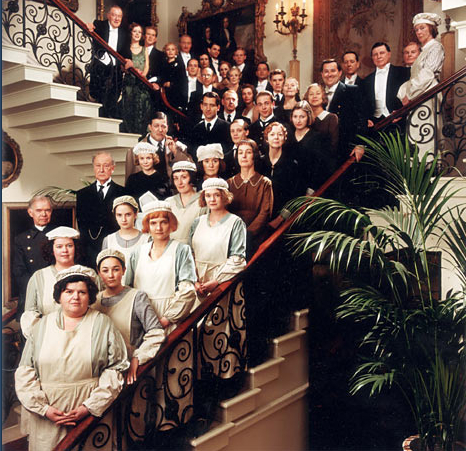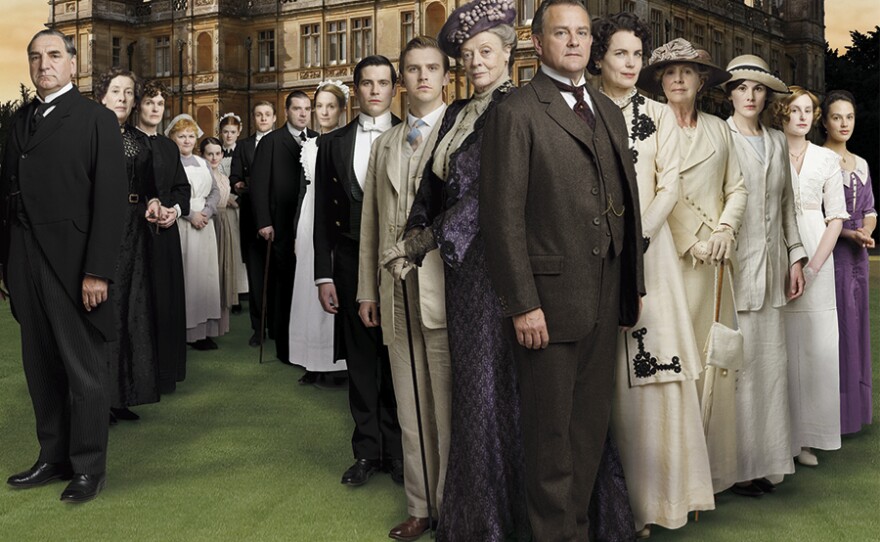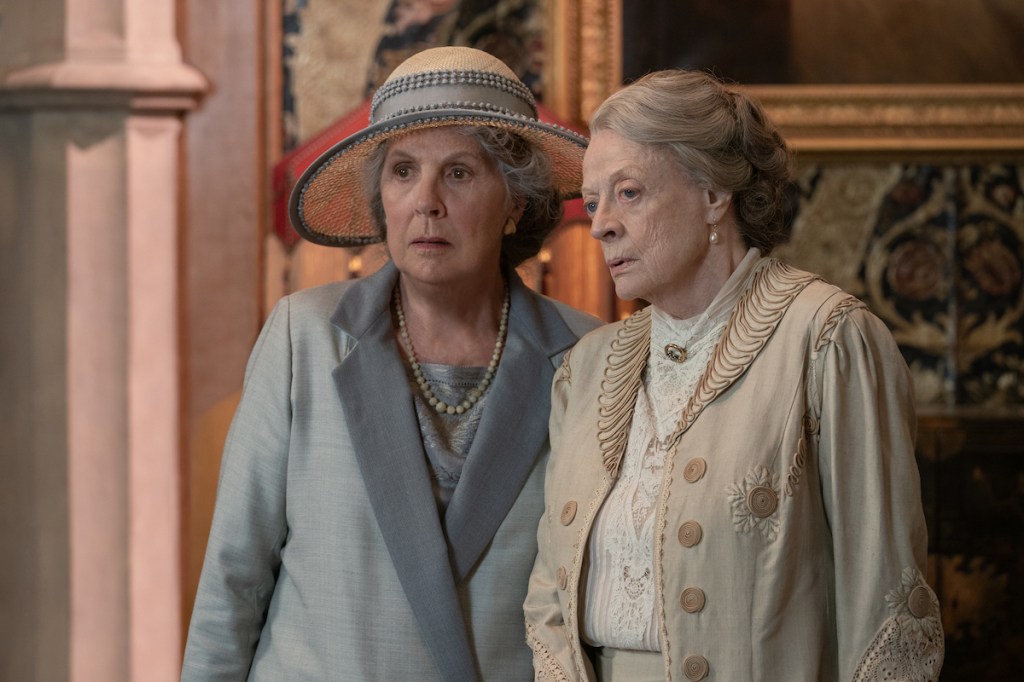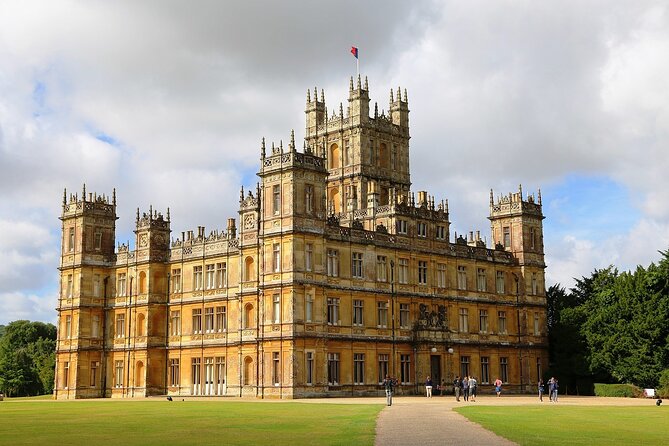Yes, my friends, I know: I do not usually review mainstream films here, as this blog is reserved for the mystery genre, albeit in all its forms. Today, however, I saw Downton Abbey: The New Era, and I would like for a moment to contemplate the mystery of Julian Fellowes.
Here’s a man, a well-born peer of the British realm, who went to Hollywood and dazzled the world with his Oscar-winning screenplay for Robert Altman’s Gosford Park (2001). Easily one of my favorite Altman films, Gosford was inspired by actor Bob Balaban’s suggestion that the director film a whodunit in the manner of Agatha Christie. Fellowes used the standard setting of a country house weekend and catered to Altman’s love of large ensemble casts by shining an equal light on the family, their guests and the servants who love/hate them in a variety of ways.
The cast was a stunning array of British talent, including Helen Mirren, Eileen Atkins, Michael Gambon, Kirsten Scott-Thomas, Stephen Fry, Alan Bates, and Derek Jacobi. And – of course – there is Maggie Smith as a dowager countess. Thirty characters populate the film, and in two hours, seventeen minutes, we get to know them all and have a murder mystery served up for us that exposes all the dastardly doings of the upper classes in British society.
The film made Fellowes a star, and the Upstairs Downstairs format would serve him well: in 2010, Fellowes created Downton Abbey, which combined the concepts of the Altman film – minus the Christie element – with the format of classic Masterpiece Theatre. The cast was led by now-Dame Maggie Smith as – of course – a dowager countess and turned a lot of British stage and film actors into household names in America. In six short seasons comprising fifty-one episodes, Fellowes attempted to cover every important historical event from 1912 to 1926 and tasked himself with giving equal weight to the thirty-three main characters (and numerous guest stars) who populated his – oh, let’s face it, people – stunningly dressed soap opera.
I watched the series . . . grudgingly. The best season was the first, which took some time to introduce us to the Crawley family and their servants, focusing upstairs on the inheritance issues faced by the family and downstairs on the mystery of Bates, the new valet. Fellowes borrowed from loads of other people’s stories: oldest daughter Mary’s conflict between dutifully marrying to keep the family in the Abbey or marrying for love (surprise! She could have both!) is pure Pride and Prejudice. Youngest daughter Sybil breaks class barriers and falls for the political firebrand/chauffeur in a take on Wuthering Heights. And middle daughter Edith complains about being ignored for the first three seasons and can’t do anything right – clearly an homage to The Brady Bunch.
By season Two, Fellowes ramped up the pace, jamming World War I and the Spanish flu into eight episodes and killing off a major character. By season Three, he was in “rinse and repeat” mode, and so on and so forth until the Season 6 finale. It didn’t matter if each twist was telegraphed a mile away, if plot twists felt repetitive or overused . . . the cast was great, Maggie Smith (aided, I must say, by the wonderful Penelope Wilton) could be relied upon to say something shocking, and the ratings stayed high.
Figuring three must be the charm, Fellowes returned to Hollywood to do for America what he had done for PBS: The Gilded Age took the same upper/lower class template and added Yankee issues about upward mobility and race relations to the mix. It put together a cast that . . . well, it included some good people, such as Christine Baranski, doing her best impression of Maggie Smith, Sex and the City’s Cynthia Nixon, showing us what would have happened to Miranda if she’d never met Steve, and Audra MacDonald, about whom I could never find a negative thing to say.
I watched the first season; the show’s a stinker.
Oh, it looks good, although it feels like every scene that happens outside is played on blue screen. And the plot moves quickly – although it does so while also managing to stand perfectly still. It has the same feel as late Downton: in a series of scenes lasting between twenty and ninety seconds, everyone talks too fast, every plotline and twist feels overly familiar. (While Downton Abbey stole from the classics, Gilded Age steals from the Abbey.) The worst of it comes from the stories involving the servants, a mishmash of types from not one, but two households, who all merge together and have very little of value to contribute to a series that should focus on the conflict between the impoverished but noble Van Rhijins, languishing in their shabby Fifth Avenue brownstone, and the nouveau riche Russells, who have built a gaudy palace right across the street.
If you ever find yourself watching one of the really old Masterpiece Theatre shows, like Upstairs, Downstairs and The Duchess of Duke Street, you might be shocked at how slowly they tell their stories. For better or worse, our attention spans have been altered by our smart phones and laptops. We want our content not so much arrayed before us as downloaded into the hard drive of our brain. That doesn’t always make for better entertainment. Gilded Age skips along, hoping the speed of its storytelling will help you miss its deficits. Still, those of us who have watched Upstairs, Downstairs, then Gosford Park and Downton Abbey have to ask the question: are these the only stories you can tell? And if so, isn’t there another way to tell them? (Even now, Fellowes it hinting – or is it a threat? – that a younger version of Lady Violet Crawley might just show up in New York in a future season of the latest incarnation of the same DAMN show!!
* * * * *
Which brings me to the reason I sat down to write this thing in the first place . . .
Downton Abbey: A New Era opened today and – can you believe it? – I went to the first showing. The audience was old. They all looked like Maggie Smith does through much of this film, but there were a lot of them in the theatre for these COVID-fearful days. I heard little laughter and no tears, although the story works hard to conjure up both. What I sensed was that the group assembled welcomed another chance to hang out with old, pre-COVID friends for a film that tried to jam eight hours of television into two hours and five minutes.
Is the film good? Not particularly, but then it doesn’t really need to be. Is it entertaining? Kind of, especially when Smith or Michelle Dockery (as Lady Mary) are onscreen. What prevents me being more positive here is the utter lack of anything original taking place on screen – and a lot takes place. We begin with a big wedding and end with a big death – although that death and funeral are followed by a quick, quick scene following a birth, to lift our spirits just before we exit the theatre and any lingering thoughts of the movie quickly dissipate.
Although Smith dominates every moment she’s onscreen, she’s actually not there for very much. (We were told at the end of the last film by the lady herself that she was ill, so it should come as no surprise that she spends most of this film in confinement.) No, this film belongs to Lady Mary and her father, the Earl of Grantham (Hugh Bonneville), who spearhead the two main storylines of the film. At least the Earl’s story is started by his mother, who is surprised to inherit a villa on the Cote d’Azur from an ancient admirer. This man’s widow wants to contest the bequest, but his son is oddly okay with it, inviting the family to come to France and sort things out.
Meanwhile, the Abbey itself is falling into ruin, and hope for salvation comes from a film company that would like to use the drawing room at Downton Abbey for its new movie, The Gambler. Someone in the family has to make sure those pesky actors and technicians treat the old house with respect. And so the film, perhaps wisely, divides the cast down the middle: the Earl and his wife (Elizabeth McGovern), daughter Edith (Laura Carmichael) and her husband, ex-chauffeur/ex-son-in-law/devoted mensch Tom (Allen Leech) and his wife and her mother (Imelda Staunton), and devoted servants Carson (Jim Carter), Bates (Brendan Coyle), and Baxter (Raquel Cassidy) are off to France, while Mary and the servants hold down the fort.
The French storyline is absolutely beautiful to look at and surprisingly bereft of drama. The main suspense is supposed to be generated by the possibility that the gift of the villa to Violet (which she has bequeathed to Tom Branson’s daughter with late-first wife Sybil) was payment for services rendered – as in maybe the Earl isn’t an earl. But the suspense it generates is weak; even daughter Edith says to her father, “Nowadays, what does this matter?” Nothing can shake things up in the villa: not the fine performance by Nathalie Baye as the late owner’s angry widow, not the health scare suffered by Cora, (which is an exact repeat of the health scare perpetrated on another character during the series finale, right down to the same disease and outcome!), not the hatred of all things French felt by Carson, which causes him to wear English clothing in the south of France and sweat profusely. No, all we can do is admire the gorgeous house and scenery and enjoy spending time with these people.
Things are a speck better back at the Abbey in what amounts to a non-musical retread of Singin’ in the Rain. The company is shut down because they are making a silent film, and sound films are all the rage. From here on in, every problem they face will be solved by a member of the Crawley entourage. Mary suggests to the director (Hugh Dancy) that instead of shelving the picture, they turn it into a sound film!! (Why did nobody at the studio think of this?) There’s no script, but valet turned-schoolteacher-turned-film buff Molesley (Kevin Doyle) likes to write scripts and ends up a turn-of-the-century Paddy Chayefsky. Then the leading lady ends up sounding just like Jean Hagen in Rain – but that’s okay! Housekeeper Mrs. Carson (Phyllis Logan) suggests Mary dub the actress’ voice! And when the actress herself balks, servants Anna and Daisy turn her life around with an appropriate pep talk. And when the leading man (Dominic West) feels lonely, he turns to butler Thomas Barrow (Rob-James Collier), fresh off his latest gay romance, for solace. (And this time – it may stick!) And when the ensemble cast quits, up in arms for not having received payment, where is the director going to find a group of willing extras who not only know how to attend a dinner party, they know how to set the table!?!
Not all storylines are created equal, but it’s amazing how Fellowes manages to maintain the “something for everyone” policy he from the series into one fifth of the time. Rumor has it that Fellowes wants one more picture “to complete the feeling of a trilogy.” One imagines that it will be called Downton Abbey: The Winds of War. Daisy’s husband will have to go off to fight, just like poor William in Season Two. The Abbey will welcome wounded soldiers, who might even find some etched in messages from their WWI counterparts. Mary will have it out once and for all with her strangely absent husband. (Is Matthew Goode TOO goode for Downton Abbey?) Edith will once again get no good story – and I hope she complains about it.
There will be at least two characters missing if Fellowes sticks to the consequences of the present film. And yet I have a feeling that he won’t kill any more characters off. Instead, the young ‘uns will grow up and realize the impossibility of keeping the Abbey up-to-date. They’ll sell it to the present owners of Highclere Castle and move to the States, where they might meet the great-grandchildren of The Gilded Age characters and start a whole new series. Maybe they’ll all move to a high-rise condo building. Some of them will live upstairs, some downstairs. There won’t be a lord or a servant in the bunch.
I will be here to scoff at it all – but first, I have to call my mom and make arrangements to see Downton Abbey: A New Era once again.






Must admit, much as I really like GOSFORD (which apart from Stephen Fry pretty much gets everything right), I never watched Downton – though I liked the original UPSTAIRS DOWNSTAIRS and DUCHESS OF DUKE STREET when they were originally on British (I really detest that infantile Masterpiece Theater soubriquet PBS came up with, I really do). So much as I enjoyed your post Brad, can’t comment on the show, sorry. I will tell you though, the am dram style trailer for the new film is truly appalling!
LikeLike
I am not immune to the effects of technology on our attention span: I loved DUCHESS OF DUKE STREET when it first came on, but when I tried to watch it again, I couldn’t. The British dramas of old were not afraid to place two people on screen and have them talk a subject to death so that you could get to know their characters, little details about the times in which they lives, and so on. Some people complain that the Joan Hickson Marples are “too slow,” and they do feel much more leisurely than the quicker-paced-but-often-appalling later Marple series. (There is a way to up the pace and still do a good job. The ten-part adaptations of BLEAK HOUSE and LITTLE DORRIT a few years back were marvelous, much better to me than the Dickens adaptations of the 80’s.)
The problem with DOWNTON is the writing and pacing. The 125-minute long movie probably had 100 scenes, amounting to short snippets of dialogue meant to move one of thirty subplots along. It’s basically a soap opera on speed, and it’s annoying.
LikeLike
For all it’s faults, and everything you said is accurate, I enjoyed the movie. It’s just 100% fan service, evne more so than the first film, which was pretty much that already.
*spoiler space*
But, it needs to end here. There is no Downton with Maggie Smith. I’ve loved (well almost) every moment with these characters, but the story has been told. And what would they do for the 3rd film anyway? We’re in 1928. I really have no desire to see how Downton reacts to The Great Depression.
LikeLiked by 1 person
I agree with you, Richard. Despite the fact that Matthew Goode’s absence meant that a new “chapter” needed to be written for Lady Mary, this feels like a finale: Edith has found a purpose through work; Thomas has found some semblance of love (as the sex servant to an egoist), which means Carson can return to work as he has always wanted to do; everyone else, even Mrs. Padmore, has coupled up, and the money is there to fix the roof. Short of more deaths and losing the house (what fun that movie would be!), what is left for the family to experience?
And yet Julian Fellowes has stated he would like this to be a trilogy. And so, in the spirit of this blog, I would respectfully suggest he return to his Gosford Park roots and kill someone off. Let’s have a rip-roaring whodunnit send us off into the sunset. I propose it be Lady Mary’s errant husband. She, of course, would be arrested (Michelle Dockery on the Dock? Beautiful!) and Bates would take a correspondence course which, coupled with his own experiences with the law, would make him an excellent solicitor. In the end, he would prove her innocence, and then everyone in the Abbey would protect the real killer – Bates’ wife Anna!!! – who murdered Mary’s husband when he drunkenly attacked her and brought up old memories of sexual assault.
I’m just saying: if there has to be a third movie, let’s do it right!
LikeLike